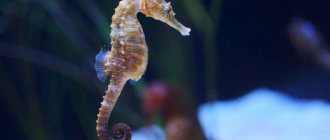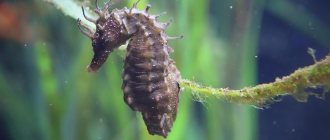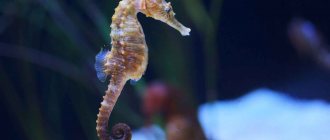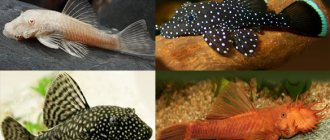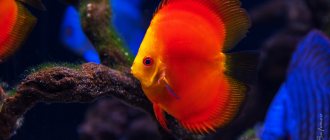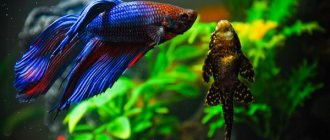Name at least one fish that is vaguely similar in appearance to a seahorse? Personally, I can’t, because this creature has a unique structure and appearance, although it belongs to the most common group of ray-finned fish. For exotic lovers, good news: keeping a couple of seahorses in your home aquarium is theoretically possible. But consider the practical side of keeping them: they will need crystal clear salt water, and problems will arise when creating other conditions and feeding. Are you ready for the obstacles?
Brief description of the seahorse
Pipit is a fish from the order Acidformes, which is distinguished by its unusual appearance. Of course, she even floats vertically. The body length is small, the limit is 20 cm, but in aquarium conditions the size will be smaller to 8-10 cm. The head of the fish has an elongated shape, vaguely resembles a horse in appearance, and its mouth is presented in the form of an elongated tube.
@ empokmaren pixabay.com
The creatures have large, round eyes that can move independently of each other, providing a 300-degree field of vision. There are plates in the cheek area to prevent accidental damage to the gills. There are growths on the head that enhance the visual resemblance to a real horse.
The head is attached to the curved body due to the presence of a long neck. The creature's belly area is noticeably thickened, and there is a large fin on its back. The body of the individual is elongated, flattened on the sides, the tail is curled into a ring, and thanks to this the horse can cling to the branches of snags and surrounding aquatic plants.
In the area where the head meets the neck there is a pair of fins. The basis of the body is an exoskeleton, and the body is covered not with scales like many fish, but with skin of a special structure.
There is variety in the shade range of individuals grown in aquariums. Skates can be:
- yellow;
- blue;
- green;
- red;
- brown;
- black and white.
The growths on the creature’s head make it invisible to other fish and help it camouflage well in corals and algae.
When buying such a creature for your aquarium, keep in mind that its digestive system is quite primitive. The horse does not have a stomach, so nutritional compounds are absorbed as they pass through the intestinal tube. Under natural conditions, fish catch food from the water and consume shrimp and small crustaceans.
Video seville pseudoscat
It must be said that various species of fish of the Balitoridae family feed in captivity not only on bacterial mucus and algae. In addition to dry food - flakes and tablets - they happily eat ice cream, or rather freshly thawed zooplankton. And according to Vadim Arbuzenko, they also actively gobble up well-washed tubifex, frozen small bloodworms and happily gnaw on pieces of lean fish or balls of minced shrimp meat. The main condition for successful feeding “without negative consequences”: a single portion should be eaten without any residue within 3-5 minutes.
Of course, in the general aquarium, balitorids have more than enough assistants in this matter. And given the small size of the Seville (about 5 cm for the male and 3-4 cm for the female), as well as their peaceful disposition, it is better for them to choose the most friendly and calm neighbors, who are also not large. Of the mobile species, use small characins, cardinals and various medium-sized rasboras. Among labyrinths, for example, lalius or small gourami are quite suitable. To revitalize the bottom area, purchase corydoras and acanthophthalmus. If a container with a similar population does not seem bright enough to you, add more small livebearers there.
In general, in an aquarium with small, peace-loving fish that do not grow more than 5 cm, Seville pseudoscts, and gastromyzonoids in general, feel much more comfortable than with peaceful, but large, or small, but territorial fish. The fast-moving Seville gets along with both, but due to some constantly present stress, they do not fully develop. In an aquarium with live plants, you can see how fish not only move along its walls, but also funny, like a monkey, jumping from branch to branch, that is, from leaf to leaf.
Photo of Seville pseudoscat
You can tirelessly watch the behavior of Seville for hours. Having a ventral sucker formed by modified pectoral and pelvic fins, fish easily move along a vertical surface, and it seems that their entire life is spent in continuous movement.
Especially funny are the funny twitching dances of fish and their mating games. Having taken a fancy to the “lady,” the male begins his galloping dance around her. At the same time, the suitor’s pelvic fins twitch in a peculiar way, creating the impression that the fish is spurring itself to take active action.
Of course, I did not think about propagating Seville, believing that this was a particularly troublesome matter, associated with the preparation of “tricky” water and other labor-intensive preparatory work. In addition, having spent my entire aquarium life studying African cichlids and cichlids in general, I did not understand at all how to approach such fish.
I didn’t look for ways of breeding, but decided to draw the attention of my friend and lover of trying to achieve the impossible from various fish, Vadim Arbuzenko, to the Seville fish. And as it turned out, I was late. By that time, Vadim had managed not only to become interested in striped Sevilles, but also to get offspring from them
By that time, Vadim had managed not only to become interested in striped Sevilles, but also to get offspring from them.
What types of fish can you keep at home?
A wild-caught seahorse will not be able to survive in an indoor aquarium. Creatures brought from a real body of water will die within a few weeks from infection or exhaustion. What is this connected with? Remember, the seahorse's digestive system is extremely sensitive, so switching to frozen food can simply kill the fish.
A certain stability can be seen in individuals bred in captivity. Such skates have good health and respond loyally to feeding frozen food. The creatures adapt easily because they simply move from one aquarium to another.
@katja pixabay.com
The most popular species among aquarists are:
- reidi;
- Hippocampus erectus;
- H. barbouri.
Seahorses raised in aquariums have good immunity and rarely suffer from infectious diseases.
How to distinguish a female and a male
Visually distinguishing males and females is not always easy.
Their main features are:
- the female is completely covered with a bony shell, the male’s lower part is free;
- the male has a clearly visible pouch in the lower part of his body in which he carries the eggs.
The seahorse is a very curious pet. It's nice to watch him and interesting to feed him.
Maintaining it is not too difficult or expensive, but you will need to properly organize the aquarium. In this case, you can even count on the appearance of offspring.
Keeping a seahorse at home: complete instructions
Just buying an unusual fish is not enough. In order for it to live for a long time and please the aquarist’s eye with its pleasant appearance, you need to take care of it, therefore it is simply necessary to create optimal conditions for keeping it:
- Choose a suitable container, that is, an aquarium. It must be at least 100 liters for a couple and at least 45 cm in height.
- The water temperature should be in the range from +18 to +25 degrees, sharp fluctuations are unacceptable, so you just need to take care of the full operation of the immersion heater.
- The acidity of the water is recommended to be increased, 8.1-8.3 pH. The presence of phosphates and nitrates in the liquid is strictly unacceptable. Tests will help identify such connections and instantly correct the situation.
- For water purification, a skimmer-floater is suitable, which does not create a powerful current. The intensity of the latter during compressor operation may be higher than permissible, so the skate may feel uncomfortable.
- Lighting should be dim, perhaps at night.
@ RicardoParra pixabay.com
The aquarium must have plants with long leaves. Only if this condition is met will the seahorse be comfortable. Additionally, it is advisable to install artificial corals and stands to which the creature can cling using its tail.
Breeding in captivity
Obtaining offspring in captivity is only possible if the animals living in the aquarium were able to create pairs. Pipits are believed to be monogamous: females lay eggs, but the male takes care of them. Animals give birth once a year.
During the mating season, the male begins to circle around his partner. The female, ready for reproduction, spins around in one place. This ritual can be repeated for more than a week.
When both partners are ready to breed, the female begins to rise up and the male should not lag behind her. Her ovipositor enlarges, and her partner’s pouch opens. The female then begins laying eggs, carefully placing the eggs in the male's pouch until it is full. Up to 600 eggs can be laid at one time.
Over the next month, the male carries the offspring. By the end of the period, fry appear, which are an exact copy of the parents, but their body is transparent and devoid of colors. The young strive to cling to any surface. Most often they connect with each other, feed on plankton and grow quickly.
Feeding the fish
Coping with the problem of feeding seahorses can be difficult. They will not eat regular pet fish food. Representatives of the ray-finned family need good nutrition - they agree to eat 6-8 shrimp per day.
You need to feed a seahorse differently than a regular aquarium fish. Often they cannot find the feeder on their own without outside help. Animals should be accustomed to it gradually, throwing food with clean tweezers.
You should take the shrimp by the tail, lower it into the water and hold it there for several minutes, and then move it, as if to lure the pet. Just a few such procedures will be enough for the creature to understand where and when it is fed and to swim to dinner itself.
What to do: the fish float to the surface
Condorita
They don't have enough oxygen. Are there any plants in the aquarium? Be sure to plant it. By the way, you started the fish early. First, it was necessary for the plants to take root properly. Throw in a couple of snails - they purify the water. And, of course, buy a device to enrich the water with oxygen.
Chingachgook the Green Snake
I had this happen. Your plants are blooming, which is why the water is cloudy. And plants can also consume oxygen rather than produce it if there is little light or under other unusual conditions. Change the water and plant other plants. And rinse the soil thoroughly under running water.
Irina
I would not recommend changing all the water, change 1/3 of the total volume (the so-called water change), before this the water should sit for at least a day in a glass jar, I usually add 0.5 tsp to the water (per 3 liters). large cook, salt) - for prevention. The water is cloudy from excess decomposing food - there are a lot of ciliates in the aquarium - a salted solution will help, unless of course the fish are completely sick, and the aquarium should not be in direct sunlight.
Lelka
After filling the aquarium and replanting the plants, you need to wait 5 days: believe me, no air conditioner (even the Tetra Aquasafe Start) will immediately make the water suitable for settling fish. Place the fish in jars with SETTENED water, replace the water in the aquarium by 1/3 and wait 5 days; plants and snails, in principle, can and should even be left. Just connect spray bottles to the jars to force air out. But there are a lot of fish, we have 75 liters, live lalius, tarakatum, labeo and crayfish, + 3 ampoules and reels. Ancistrus and speckled catfish are waiting their turn after quarantine for replanting. But the telescope and the veiltail live separately. They grow very large.
Elena Gabrielyan
You initially equipped the aquarium incorrectly. The first stage: the aquarium is installed, the soil is thoroughly washed, water is added, all equipment is installed (filter, water heater - the filter power should be 800 L/hour, ask the seller) and left for 7-10 days without planting fish . After 10 days, plants are planted, the water temperature in the aquarium is checked and adjusted if necessary. Stage 2: planting. (depending on taste) and aquarium decoration. During this time, the water may turn white - this is normal. As soon as the plants adapt and begin to grow, the water will clear itself. Conditioner is added to the aquarium to speed up water preparation, but does not replace the biological processes associated with the beginning of the functioning of the aquarium. During the time of proper arrangement of the aquarium, if possible, you need to transfer the fish to an already prepared aquarium. and remake yours. The aquarium is being prepared for occupancy within a month. there is no hurry. The fish float to the surface because the water is not ready; a sudden change in the chemical composition can lead to the death of the fish in a very short time. Scaries and telescopes are not compatible with each other. Goldfish are kept separately from everyone else. You can’t plant living plants with them either; while digging in the soil, they will break them and partially eat them. Do not overfeed your fish with dry food. The water can become cloudy because you give it too much, they don’t have time to eat it and the rhv, decomposing at the bottom, sweats the water, hence the unpleasant smell in the aquarium. You can try to purify the water, purchase a water purification conditioner from a specialized store and add it to the aquarium. BEFORE use, read the instructions or ask a qualified specialist how to use it correctly. I wish you success in this hobby.
Victoria
It is recommended to stand tap water for a period of time. 3 days, but you can speed up the preparation process - heat the water to 50-60 degrees (do not boil!) and let it stand for at least 5-6 hours - you can pour it into the aquarium. Proven by many years of experience!
Optimal neighborhood
Many breeders believe that seahorses should live in an aquarium without other species as neighbors. Yes, this will make care easier, but one can argue with such a recommendation. This unusual fish gets along well with certain species:
- dogfish;
- cardinal;
- royal scales;
- goby.
You can place snails or small crayfish in a large aquarium.
Keeping a seahorse in an aquarium at home is quite difficult, but quite possible. Initially, it is worth considering that you will have to take care of it more than the most capricious fish, and this means time, effort and additional funds.
What unusual fish live in your aquarium? Leave their photos in the comments, share your observations and experiences.
Diseases
Little is known about the diseases of these fish. They are affected by viral diseases, some protozoans and bacterial aeromonosis.
Infection can occur both from sick animals and contaminated decor that have entered the aquarium, and spontaneously, under the influence of stress.
Sick fish are removed from the main aquarium to a quarantine aquarium. There should be no living creatures or plants in it, only plastic algae and stones in which a sick animal can hide. The light in such an aquarium should be dim, weaker than in the main one.
Antibiotics ciprofloxacin and chloramphenicol are used to treat bacteria.
The following measures can be taken as prevention:
- quarantine all newly arrived pipits for several days;
- when transplanting skates, treat them with anti-stress medications;
- regularly inspect each fish, and if you notice spots, bubbles, whitening of body parts, wounds, or other abnormalities, immediately send it to quarantine;
- All decor must be cleaned and disinfected upon installation.
In the absence of disease and good prevention, the average horse lives 3-4 years.
